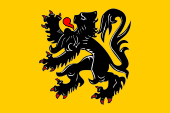mobile View, to the German Version tap the flag


- autonomous Region in Belgium
- own names: German: Flandern, French: Flandre, Flemish: Vlaanderen
- look also: historical Flanders
• Flag
• Meaning/Origin of the Flag
• Map
• Numbers and Facts
• History
• Origin of the Country's Name

Flag of Flanders,
ratio = 2:3,
Source, by: Flags of the World






The old county of Flanders showed gyronny yellow and blue with a red heart shield. Probably under the rule of the Habsburgs (since 1482), the county of Flanders was handed over a new coat of arms. It showed a black, red armored lion on gold, a symbolism that is still very well known and widespread today, not least as a symbol for Flanders as a federal part of today's Belgium.
Source:
Volker Preuss


Position in Belgium:

Source: Vascer, CC BY-SA 3.0, via Wikimedia Commons

Area: 5.260 square miles
Inhabitants: 6.589.069 (2019), mostly Flemings, further Walloons and Germans
Density of Population: 1.253 inh./sq.mi.
Capital: Brussels (Brüssel, Bruxelles, Brussel), 181.726 inh. (2019)
official Language: Flemish, regional French (Wallonian)
Currency: 1 Euro (EUR, €) = 100 Cents
Time Zone: GMT + 1 h
Source: Wikipedia (D)

58–51 B.C. · Roman conquest
3rd Century A.D. · settlement by Franks and Frisians
481–843 · to the Frankonian Empire
880 · Treaty of Verdun and Ribbemont, by the division of the Frankish Empire comes West-Flanders to the West Frankish kingdom (France) and East-Flanders to the East Franconian Empire (German Empire)
1051 · Balduin VI. (West Flanders) unites by marriage Flanders and the County of Hainaut
1384 · Flanders comes to Burgundy and to the German Empire by marriage
1482 · Flanders becomes a Habsburg possession
1556 · Flanders comes to the Spanish lineage of the House of Habsburg
1795 · conquest and annexation by France
1815–1830 · to the United Netherlands
1830 · creation of Belgium with the aim of a French speaking state to be, Flanders becomes annexed to Belgium
about 1840 · foundation of the "Flemish movement" to preserve the language and Flemish culture
about 1880 · foundation of the "Walloon movement" as an adversary
1898 · "Equality Act", Belgium is officially a bilingual country
1962–1963 · Definition of the linguistic border between the cultural communities, Brussels is bilingual, recognition of the German language as a regional language in Eastern Belgium
1970 · first Belgian state reform, the cultural communities become an constitutional rank
1980 · second Belgian state reform, creation of the Flemish Region with status of autonomy
1983 · creation of the German Community in Eastern Belgium as part of Wallonia
1988 · third Belgian state reform, expansion of regional autonomy, creation of the Region Brussels-Capital
1994 · fourth Belgian state reform, division of the former province of Brabant, further strengthening of the autonomy of regions, Belgium becomes a federal state
2001 · fifth Belgian state reform, further strengthening of the autonomy of the regions
Source: Atlas zur Geschichte,
Wikipedia (D)

The name "Flanders" goes back the old word "Fladmari", what means "shallow marshes" and it stated at the beginning only the area around the city of Bruges.
Source: Handbuch der geographischen Namen


![]()







